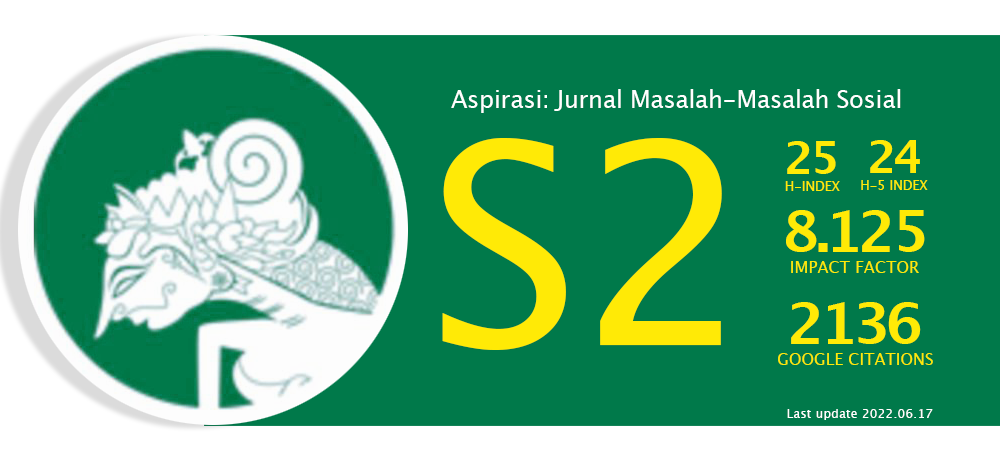Faktor Psikososial dalam Interaksi Masyarakat dengan Gerakan LGBT di Indonesia
Abstract
In this paper we elaborate the psychosocial factors that affecting Indonesian community in dealing with LGBT movement. There has been an increase of LGBT campaign in the beginning of 2016 where they’re demanding protection from discimination, violence, and constitutional barriers. However, LGBT is still considered deviation to local wisdom, making it abnormality according to American Psychiatry Association (APA)’s guidance. LGBT movement is in contrast with most people’s belief, healthy behavioral patterns, and positive children’s developmental phase. Parents are worry that their kids will engage in sexual disorder. Childhood is the most important phase to prepare for functional adulthood. Thus, government is clear when saying there’s no room for LGBT movement. Even so, as a citizen, LGBT people are the subject that must abide and be protected by the law. Therefore, government must implement the law precisely without exception to make sure everyone’s safe. At the same time, government need to deliver more education and socialization to increase respecting behavior among citizens.
Dalam tulisan ini kami mengelaborasi faktor-faktor psikososial yang memengaruhi komunitas Indonesia ketika berhadapan dengan gerakan LGBT. Terjadi peningkatan kampanye LGBT pada awal 2016 dimana mereka menuntut perlindungan dari diskriminasi, kekerasan, dan hambatan konstitusional untuk melakukan perkawinan sesama jenis. Akan tetapi, LGBT dianggap bertentangan dengan kearifan lokal, sehingga dapat disebut abnormalitas sesuai dengan petunjuk American Psychiatry Association (APA). Gerakan LGBT bertentangan dengan keyakinan kebanyakan orang, pola-pola perilaku sehat, dan tahap perkembangan anak yang positif. Orang tua khawatir jika anaknya melakukan perilaku seksual yang menyimpang. Masa kanak-kanak merupakan fase yang paling penting untuk mempersiapkan pada masa dewasa yang fungsional. Selain itu, Pemerintah juga sudah jelas menyatakan bahwa tidak memberikan ruang bagi gerakan LGBT. Akan tetapi, sebagai warga negara pelaku LGBT harus tunduk dan dilindungi peraturan yang ada. Oleh karena itu, pemerintah perlu mengimplementasikan hukum secara tepat dan tanpa pengecualian untuk memastikan semua orang terlindungi. Bersamaan dengan itu, pemerintah juga melakukan edukasi dan sosialisasi untuk meningkatkan perilaku saling menghormati sesama warga negara.
Keywords
Full Text:
pdfReferences
Buku
Baron, Robert A. & Byrne, Donn. 2004. Psikologi Sosial
(Edisi Kesepuluh). Jakarta: Penerbit Erlangga.
Bertens, K. 2016. Psikoanalisis Sigmund Freud. Jakarta: PT. Gramedia Pustaka Utama
Boellstorff, Tom. 2005. The Gay Archipelago. Amerika Serikat: Princeton University Press.
Goleman, Daniel. 2015. Social Intelligence. Jakarta: PT Gramedia Pustaka Utama.
Kartono, Kartini. 2009. Patologi Sosial 1. Jakarta: Rajawali Press.
Nolen-Hoeksema, Susan. 2007. Abnormal Psychology (4th Edition). New York: McGraw-Hill.
Papalia, Diane E; Old, Sally Wendkos & Feldman, Ruth Duskin.2008. Human Development (edisi ke-9). Jakarta: Kencana.
Rhona K. M. Smith, dkk. 2008. Hukum Hak Asasi Manusia. Yogyakarta: Pusat Studi Hak Asasi Manusia Universitas Islam Indonesia (PUSHAM UII), hlm. 39-40.
WHO. 2015. Sexual Health, Human Rights and the Law.Geneva: World Health Organization
Jurnal
Arreola, S., Santos, G., Beck, J., Sundararaj, M., Wilson,P. A., Hebert, P., Ayala, G. 2015. “Sexual Stigma, Criminalization, Investment, and Access to HIV Services Among Men Who Have Sex With Men
Worldwide.” AIDS and Behavior, 19 (2), 227-234.
Bariola, E., Lyons, A., Leonard, W., Pitts, M., Badcock,P., & Couch, M. 2015. “Demographic and Psychosocial Factors Associated with Psychological Distress and Resilience Among Transgender individuals.” American Journal of Public Health,105 (10), 2108-2116.
Centers for Disease Control and Prevention (CDC).1982. “A Cluster of Kaposi’s Sarcoma and Pneumocystis carinii Pneumonia among Homosexual Male Residents of Los Angeles and Range Counties,
California.” MMWR 31 (23): 305-307.
Dye, Kelly; Mills, Albert J. & Weatherbee, Terrance.2005. “Maslow: Man Interrupted: Reading Management Theory in Context.” Management Decision Vol. 43 No. 10, hlm. 1375-1395.
Friedman, R. C., & Downey, J. I. 1998. “Psychoanalysis and the Model of Homosexuality as Psychopathology: A Historical Overview.” American Journal of Psychoanalysis, 58 (3), 249-70.
Harris, Angelique; Battle, Juan; Pastrana, Antonio (Jay), Jr.; Daniels, Jessie. 2013. “The Sociopolitical Involvement of Black, Latino, and Asian/Pacific Islander Gay and Bisexual Men.” The Journal of
Men’s Studies, Vol. 21, No. 3, FALL 2013, 236-254.
Hofstede, Geert. 2011. “Dimensionalizing Cultures: The Hofstede Model in Context.” Online Readings in Psychology and Culture, 2(1).
Khan, Reshma Muqtedar. 2013. “Travel Motivations of Gay and Lesbian Tourists: A Qualitative Inquiry.” Thesis.
LaSala, Michael C. 2013. “Out of Darkness: Three Waves of Family Research and the Emergence of Family Therapy for Lesbian and Gay People.” Clinic Soc Work J (2013) 41:267-276.
Rado, Sandor.1940. “A Critical Examination of the Concept of Bisexuality.” Psychosomatic Medicine, 2 (October 1940) 4: 459-467.
Ryan, Caitlin, et al.2010. “Family Acceptance in Adolescence and the Health of LGBT Young Adults.” Journal of Child and Adolescent
Psychiatric Nursing, Volume 23, Number 4, hlm.205–213.
Singh-Manoux. A.2003. “Psychosocial Factors and Public Health.” J Epidemiol Community Health. 57: 553–554.
Tinney, Jean; Dow, Briony; Maude, Phillip; Purchase, Rachel; Whyte, Carolyn; & Barrett, Catherine. 2015. “Mental Health Issues and Discrimination among Older LGBTI People.” International
Psychogeriatrics, 27: 9, 1411–1416.
Vinjamuri, M. 2015. “Reminders of Heteronormativity: Gay Adoptive Fathers Navigating Uninvited Social Interactions.” Family Relations, 64(2), 263-277. diakses dari https://search.proquest.com/docvie
w/1662078883?accountid=185286.
Zimmerman,Kevin John. 2013. “Maintaining Commitment in Long-Lasting Mixed Orientation Relationships: Gay Men Married to Straight
Women.” Graduate Theses and Dissertations. Paper 13464.
Laporan
Kementerian Kesehatan RI: Pusat Data dan Informasi. 2014. Situasi dan Analisis HIV AIDS. Jakarta: Kementerian Kesehatan RI.
UNDP & USAID. 2014. Hidup sebagai LGBT di Asia: Laporan Nasional Indonesia.
APA. 2013. Gender Dysphoria. http://www.dsm5.org/
documents/gender%20dysphoria%20fact%20sheet.
pdf, diakses tanggal 10 November 2016.
Undang-Undang
Undang-Undang No. 1 Tahun 1974 tentang Perkawinan.
Undang-Undang No. 12 Tahun 2011 tentang Pembentukan Peraturan Perundang-Undangan.
Undang-Undang No. 18 Tahun 2014 tentang Kesehatan Jiwa.
Surat Kabar
“Tindak Tegas Kampanye LGBT: Menurut UU Perkawinan, LGBT tergolong Ilegal.” Suara Pembaharuan, 23 Februari 2016.
Hafidhuddin, Didin. “Mencegah Bencana Kemanusiaan”. Republika, 21 Februari 2016.
Nasution, Maneger. “Perspektif HAM Perkawinan Sesama Jenis”. Republika, 28 Januari 2016.
Website
APA. 2016. “Lesbian, Gay, Bisexual, Transgender.” http://www.apa.org/ topics/lgbt/index.aspx, diakses
Oktober 2016.
Endres, Nicholai, Kertbeny, Károly Mária. 2016. http://www.glbtqarchive.com/ssh/kertbeny_km_S.pdf,
diakses 10 November 2016.
Jong, Hans Nicholas. 2016. “LGBT Persecution Continues
with Apps Ban.” http://www. thejakartapost.com/
news/ 2016/09/17/lgbt-persecution-continues -withapps-ban.html, diakses 19 September 2016.
Murdaningsih, Dwi. 2016. “Kaum LGBT Tuntut 3 Hal Ini Kepada Pemerintah.” http://nasional.republika.
co.id/berita/nasional/umum/16/02/20/o2tt4d368-
kaum-lgbt-tuntut-3-hal-ini-kepada-pemerintah, diakses 26 Februari 2016.
Wurinanda, Iradhatie. 2016. “Ini Enam Poin Tuntutan LGBTIQ Indonesia.” http://news.okezone.com/read/2016/01/27/65/1298518/ini-enam-pointuntutan-lgbtiq-indonesia?page=2, diakses 26
Februari 2016.
WHO. tt. “Growing Recognition of Transgender Health,
Bulletin of the World Health Organization,” http://www.who.int/ bulletin/volumes/ 94/11/16-021116/en/, diakses 28 Juli 2016.
“Gila! 17.000 Anak LBGT Tersebar di Jawa Barat”, http://www.kpai.go.id/ berita/ gila-17-000-anaklbgt-tersebar-di-jawa-barat/”, diakses 9 November 2016.
“History of HIV and AIDS Overview”, http://www.
avert.org/professionals/history-hiv-aids/overview,
diakses 7 November 2016.
“Ketua KPAI: 33 Persen Tindakan Kriminal Disumbang
Perilaku LGBT”, http://www.kpai.go.id/berita/
ketua-kpai-33-persen-tindakan-kriminaldisumbang-perilaku-lgbt/, diakses tanggal 9 November 2016.
“Komisi VIII Dapat Aspirasi Usulan RUU Anti LGBT”, http://dpr.go.id/berita/detail/ id/13017, diakses 26 Oktober 2016.
“Lesbian, gay, bisexual, transgender”, http://www.apa.
org/topics/lgbt/index.aspx , diakses 3 Oktober 2016.
“The History of Psychiatry & Homosexuality”,http://www.aglp. org/ gap/1_history/, diakses 10 Oktober 2016.
“Transgender”,http://www.aglp.org/gap/6_transgender/, diakses 10 November 2016.
“Sejarah Gay, Waria, Lesbian”, https://gayanusantara.or.id/info-lgbtiq/ lgbtiq-history/, diakses 1 November 2016.
DOI: https://doi.org/10.46807/aspirasi.v7i2.1288
Refbacks
- There are currently no refbacks.







